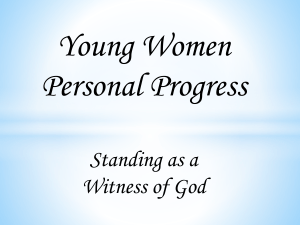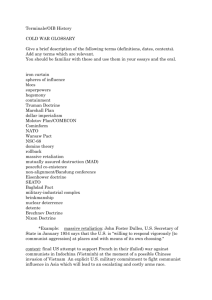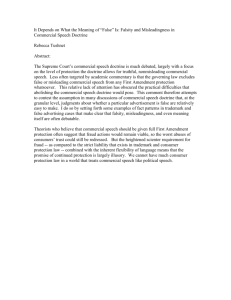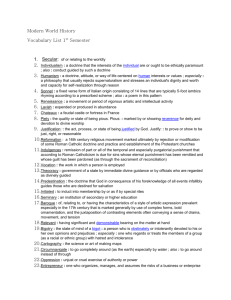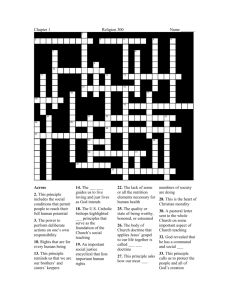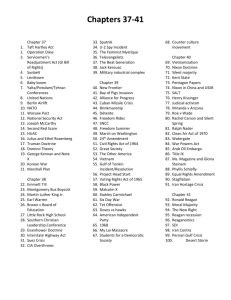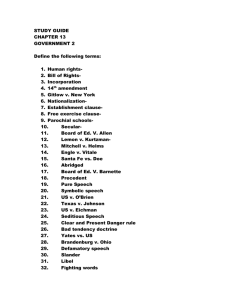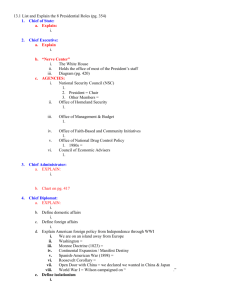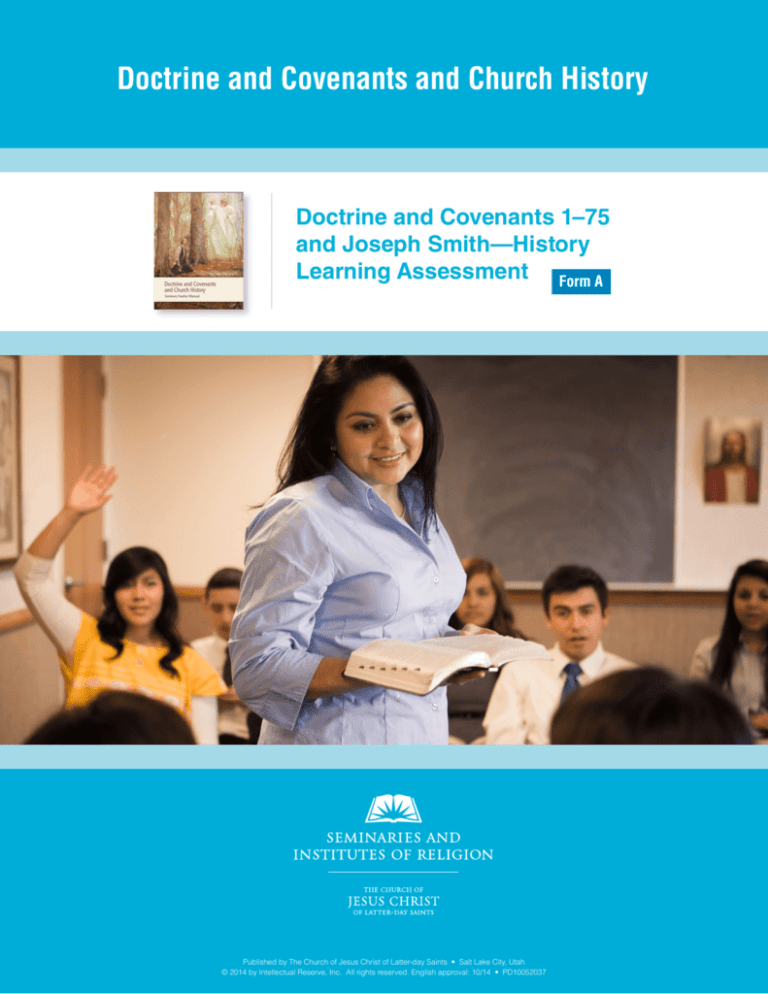
Doctrine and Covenants and Church History
Doctrine and Covenants 1–75
and Joseph Smith—History
Learning Assessment Form A Published by The Church of Jesus Christ of Latter-day Saints • Salt Lake City, Utah
© 2014 by Intellectual Reserve, Inc. All rights reserved. English approval: 10/14 • PD10052037
i
CONTENTS
Teacher Packet
Introduction 1
Administering the Learning Assessment 1
Reviewing the Learning Assessment 1
Making Accommodations for Students with Disabilities 2
Sending Answer Sheets and Feedback to the Seminaries and Institutes Office of Research 3
Correct-Response Guide for Section 1: Multiple Choice 4
Correct-Response Guide for Section 2: Explain Doctrine 11
Student Learning-Assessment Packet
Answer Sheet for Doctrine and Covenants 1–75 and Joseph Smith—History Learning Assessment, Form A 14
Section 1: Multiple Choice 15
Section 2: Explain Doctrine 20
Section 3: Belief and Apply Surveys 21
ii
Teacher Packet
Introduction
This learning assessment is for seminary students. Teachers should administer the assessment after they have taught the
corresponding seminary curriculum lessons.
The learning assessment is a 60-minute learning experience. In a daily class, administering the assessment will take one
class period, or 40 minutes. Reviewing the assessment with your class will be done the following class period. Classes that
meet longer than 60 minutes should take only one class period to administer and review the assessment.
Administering the Learning Assessment (AVERAGE TIME: 40 MINUTES)
1. Before the day that students take the assessment, identify students who may need accommodations because of specific
needs, disabilities, or health-related conditions. Share the following statement with your class two or three days before
giving the assessment:
Testing accommodations can be made for students with specific needs, disabilities, or health-related conditions
that prevent them from participating in the assessment on an equal basis with other students.
If you have a specific need, disability, or health-related condition that may prevent you from participating in the
assessment on an equal basis with your peers, please talk with me to discuss possible testing accommodations
that may help you.
Make appropriate accommodations to meet the specific needs, disabilities, or health-related conditions identified (see
the “Accommodations for Students with Disabilities” section on page 2).
2. Make one copy of the Student Learning-Assessment Packet for each student. Print the packets on white paper.
3. Ensure that each student has a pencil that can create dark circles and an eraser as he or she fills in the answer sheet.
Do not use red scripture-marking pencils.
4. Pass out the copies of the Student Learning-Assessment Packet to the students.
5. Instruct students to write their names on their answer sheets.
6. Write the program ID number on the board. Have students mark the program ID on their answer sheets.
7. Read the following instructions to your class in a professional manner:
The purpose of this learning assessment is to see how well you understand what we have studied in this class
and to help you continue learning. There are three sections: multiple choice, explain doctrine, and survey.
You may not use your scriptures during the assessment.
Please give your best efforts on this assessment. You may begin.
Reviewing the Learning Assessment
1. Provide one copy of the “Correct-Response Guide for Section 2: Explain Doctrine” for each student. Instruct the students
to self-grade what they wrote in the explain doctrine section. Some students will finish before others, so ask those who
finish early to remain quiet as others finish their assessment.
1
2. After all students have finished, review the multiple-choice answers as a class. Ask students to grade their own
answers as you read the correct answers aloud. (For example, “The answer to number 1 is c, number 2 is a, . . .”) Use
the correct-response guides in the teacher packet to explain and discuss answers to any of the learning assessment
questions students may not understand.
3. Students should keep their Belief and Apply Surveys. Take a few minutes to explain the importance of evaluating how
well they are applying gospel principles in their lives. Do not ask students to share their specific responses on the
suveys, but have a discussion that helps them see and feel the importance of striving to become better in applying
gospel principles in their lives. Encourage them to take a minute to write down what they feel will help deepen their
testimony of these doctrines and principles. Ideas may include setting a goal to start doing some of the things or to do
them better, to do some things more sincerely, or to share what they know about the gospel with friends or family.
4. Instruct students to write the number of questions they correctly answered in the top-right corner of their answer sheet
and give their answer sheets and explain-doctrine responses to you. Students should keep their completed Belief and
Apply Surveys.
5. Enter the student results into the WISE Gradebook. Select Yes for students who answered 75 percent or more of the
questions correctly. Select No for students who answered less than 75 percent of the questions correctly. (For this
36-question learning assessment, students should answer 27 or more questions correctly to pass.)
6. If any students answered less than 75 percent of the questions correctly, work with them to help them pass the learning
assessment. Encourage them to study and take the learning assessment again. Based on the students’ needs and
abilities, you may suggest that they use their scriptures, the teacher, a parent, a Church leader, or a knowledgeable
friend to help them find the answers during these additional attempts. The learning assessment can help students learn
some of the important doctrines, principles, scripture mastery, content, and context of the course. Make adaptations as
necessary to meet the needs and abilities of your students.
7. Update the results in the WISE Gradebook after a student passes the assessment. Change the results from “No” to “Yes”
for that student.
Making Accommodations for Students with Disabilities
The purpose of assessment accommodations is to enable students with specific needs, disabilities, or health-related
conditions to participate in the assessment on an equal basis with other students. Teachers should make appropriate
accommodations to meet the specific needs, disabilities, and health-related conditions of their students. The following are
guidelines to consider as you make accommodations for your students:
1. Identify students who may have specific needs or disabilities. Have a private conversation with each student to identify
his or her specific need(s). Listen attentively, and be positive. You may consider having conversations with these
students’ parents or Church leaders to help you better understand their specific need(s).
2. Based on your conversations, make a plan that appropriately accommodates the student’s specific need(s).
3. Implement the accommodations. Individual accommodations should remain confidential. It is impossible to list all of the
possible accommodations; however, the following are several examples of possible accommodations:
Presentation: Provide the student with an audio version of the assessment, present the instructions and assessment
orally, or provide the student with a large-print version of the assessment (see the Learning Assessments website for the
currently available formats of the assessment).
Setting: Provide the student with preferential seating in the classroom, provide a space with minimal distractions, or
administer the assessment in a small-group setting or in another room.
Test scheduling: Administer the assessment in several sessions or over several days, allow the various parts of the
assessment to be taken in a different order, administer the assessment at a specific time of day, or allow extended time
to complete the assessment.
Response: Allow the student to make verbal responses of his or her answer choices, allow for answers to be dictated to
a scribe or recorder, or permit answers to be marked in the assessment booklet rather than on the answer sheet.
4. Avoid making accommodations that change or reduce the learning expectations of the student.
5. Have Christlike love for each student, and follow the promptings of the Spirit as you make accommodations to meet
students’ needs.
2
6. Go to the following Church website to find more general information on helping individuals with disabilities:
lds.org/topics/disability.
Sending Answer Sheets and Feedback to the Seminaries and Institutes Office of
Research (OPTIONAL)
Sending in your students’ answer sheets and providing feedback to the Seminaries and Institutes of Religion Office of
Research provides valuable information that will be used by Seminaries and Institutes of Religion administrators to improve
this assessment and Seminaries and Institutes of Religion curriculum. A reporting system for these assessments is currently
being developed. However, until that system is operating, no teacher reports can be returned to teachers. If you wish to send
your students’ results or feedback, do one of the following:
1.
Mail your answer sheets to:
Seminaries and Institutes of Religion
Office of Research
50 East North Temple Street
Salt Lake City, UT 84150-0009
2. Scan and email your answer sheets by following these steps:
a. Scan the answer sheets at 300 dots per inch (dpi) resolution and save them to a computer. Make sure all pages
scan correctly.
b. Compile all scans into one PDF file per teacher, not 30 separate PDF files for 30 students.
c. Email the PDF files to si-processing@ldschurch.org. If the file is more than 12 MB, use FileSend at
https://filesend.ldschurch.org. You may also use personal file-sharing services, such as Dropbox or Box, to send
your files to si-processing@ldschurch.org.
3. Your feedback and suggestions are appreciated. We welcome your comments regarding the assessment, the
assessment process, challenges, and successes.
•
•
•
Survey link: Learning Assessment Feedback
Email: si-research@ldschurch.org
Mail comments to the above address.
3
Correct-Response Guide for Section 1: Multiple Choice
Review the multiple-choice answers as a class. Ask students to grade their own answers as you read the answers aloud. Ask
them to write an X next to the number of the question they miss. Students should not change their answers on their answer
sheet or put an X in a bubble as they review the correct responses. Explanations are provided to help you explain and
discuss questions students may not understand. Do not read aloud the explanations for every question.
1.
What important mission did the Prophet Joseph Smith have that was similar to that of Adam, Enoch, Noah,
and Moses?
Correct answer:
(d) He was the head of a dispensation and given priesthood keys to direct the Lord’s work on the earth.
Adam, Enoch, Noah, Moses, and others were heads of gospel dispensations. Joseph Smith is the head of the
dispensation in which we live—the dispensation of the fulness of times. This final dispensation began with the
Restoration of the gospel through the Prophet Joseph Smith. It is called the dispensation of the fulness of times because
all keys that the Lord has revealed for the blessing of His children have been restored and all the Lord’s plans and
purposes since the world began will be fulfilled” (Doctrine and Covenants and Church History Seminary Teacher Manual
[2013], 112; see also D&C 27:5–14; 65:2).
2. What principle did the Lord teach Joseph Smith when the 116 manuscript pages were lost?
Correct answer:
(a) “You should not have feared man more than God” (D&C 3:7).
“Although God said that His work could not be frustrated, He also wanted the Prophet to understand the mistakes he
had made and the consequences of those mistakes” (Doctrine and Covenants and Church History Seminary Teacher
Manual, 38). The Lord taught Joseph Smith that even though he felt pressure from Martin Harris, he should have listened
to the first answer from God to not let Martin have the 116 manuscript pages (see D&C 3:7–8).
3. Only the President of the Church can receive --------.
Correct answer:
(b) revelation to direct the entire Church
“Only the President of the Church can receive revelations for the entire Church” (Doctrine and Covenants and Church
History Seminary Teacher Manual, 169; see also D&C 21:1, 4–6; 28:2, 6–7; 43:1–7).
4. After the death of the Savior’s original Apostles, some gospel doctrines and principles were corrupted. What is
one thing the Lord provided during the Restoration to overcome these corruptions?
Correct answer:
(c) He provided the Book of Mormon to teach and clarify key doctrines of the gospel.
“The Book of Mormon is evidence that God has restored the gospel in our day. . . .
“The Book of Mormon teaches and clarifies key doctrines of the gospel” (Doctrine and Covenants and Church History
Seminary Teacher Manual, page 89; see D&C 20:8–12).
4
5. Which of the following is one way the Doctrine and Covenants teaches us to be prepared for the Second Coming
of Jesus Christ?
Correct answer:
(b) Take the Holy Spirit for our guide.
“If we receive the truth and take the Holy Spirit to be our guide, we will abide the Savior’s Second Coming” (Doctrine and
Covenants and Church History Seminary Teacher Manual, 179; see D&C 45:57).
6. Why are general conference talks considered scripture?
Correct answer:
(a) What the Lord’s servants say when moved upon by the Holy Ghost is scripture.
“And whatsoever they shall speak when moved upon by the Holy Ghost shall be scripture, shall be the will of the Lord,
shall be the mind of the Lord, shall be the word of the Lord, shall be the voice of the Lord, and the power of God unto
salvation” (D&C 68:4, see also Doctrine and Covenants and Church History Seminary Teacher Manual, 251).
7. What was the first divine witness that Oliver Cowdery received that helped him understand that the work of
Joseph Smith was from God?
Correct answer:
(c) The Lord spoke peace to Oliver Cowdery’s mind.
“Verily, verily, I say unto you, if you desire a further witness, cast your mind upon the night that you cried unto me in your
heart, that you might know concerning the truth of these things.
“Did I not speak peace to your mind concerning the matter? What greater witness can you have than from God” (D&C
6:22–23).
The Prophet Joseph Smith reported that “after we had received this revelation [in Doctrine and Covenants 6], Oliver
Cowdery stated to me that after he had gone to my father’s to board, and after the family had communicated to him
concerning my having obtained the plates, that one night after he had retired to bed he called upon the Lord to know
if these things were so, and the Lord manifested to him that they were true, but he had kept the circumstance entirely
secret, and had mentioned it to no one; so that after this revelation was given, he knew that the work was true, because
no being living knew of the thing alluded to in the revelation, but God and himself” (History of the Church, 1:35; see also
Doctrine and Covenants and Church History Seminary Teacher Manual, 51).
8. When the Lord gave a revelation about the sacrament, what was He referring to when He said “it mattereth not”
(D&C 27:2)?
Correct answer:
(b) What we eat or drink
“[A] heavenly messenger told Joseph Smith that it mattered not what should be used for the Sacrament” (Church History
and Modern Revelation, 2 vols. [1953], 1:132).
“As we partake of the sacrament, we are to remember the atoning sacrifice of Jesus Christ” (Doctrine and Covenants
and Church History Seminary Teacher Manual, 111). What we use as emblems of the sacrament is not as important as
what those emblems help us remember. (See D&C 27:1–2.)
9. Which of the following is NOT taught in the Doctrine and Covenants about missionary work?
Correct answer:
(c) All of Heavenly Father’s children will one day join the Church.
5
President Dieter F. Uchtdorf of the First Presidency taught: “In this Church that honors personal agency so strongly, . . .
we respect those who honestly search for truth. It may break our hearts when their journey takes them away from the
Church we love and the truth we have found, but we honor their right to worship Almighty God according to the dictates
of their own conscience, just as we claim that privilege for ourselves” (“Come, Join with Us,” Ensign or Liahona, Nov.
2013, 22).
(a) “The gospel of Jesus Christ will go forth to the ends of the earth” (Doctrine and Covenants and Church History
Seminary Teacher Manual, 242; see D&C 65).
(b) “If we open our mouths to declare the gospel, the Lord will inspire us with what to say” (Doctrine and Covenants and
Church History Seminary Teacher Manual, 133; see D&C 33:7–10).
(d) “Our efforts to bring others to Jesus Christ are of great worth to us” (Doctrine and Covenants and Church History
Seminary Teacher Manual, 67; see D&C 15:6; 16:6).
10. The Atonement of Jesus Christ makes it possible for us to --------.
Correct answer:
d) All of the above.
“Through His Atonement, Jesus Christ offers forgiveness and eternal life to all those who exercise faith in Him and repent
of their sins” (Doctrine and Covenants and Church History Seminary Teacher Manual, 124; see D&C 29:30–45).
11. Your friend has decided to join the Church but doesn’t understand why she needs to be baptized again because
she was already baptized in another church. Why does she need to be baptized again?
Correct answer:
(a) Baptism must be performed by the authority of the priesthood and under the direction of those who hold priesthood
keys.
“Baptism must be done by immersion and performed by one holding proper authority” (Doctrine and Covenants and
Church History Seminary Teacher Manual, 94; see D&C 20:72–74; see also D&C 22).
12. What truth(s) can we learn from Joseph Smith’s First Vision?
Correct answer:
(e) All of the above.
(a) “Heavenly Father knows us by name” (Doctrine and Covenants and Church History Seminary Teacher Manual, 21;
see Joseph Smith—History 1:17).
(b) “If we ask God in faith, He will answer our prayers” (Doctrine and Covenants and Church History Seminary Teacher
Manual, 21; see Joseph Smith—History 1:11–19).
(c) “God the Father and His Son, Jesus Christ, are separate and distinct beings” (Doctrine and Covenants and Church
History Seminary Teacher Manual, 21; see Joseph Smith—History 1:17).
(d) “If we earnestly seek God’s help when Satan tries to discourage us, God can deliver us” (Doctrine and Covenants
and Church History Seminary Teacher Manual, 21; see Joseph Smith—History 1:16–17).
13. According to Doctrine and Covenants 19:16–19, what is one reason the Savior suffered for our sins?
Correct answer:
(a) So we could repent and not have to suffer as He did
“The Savior suffered for our sins so we could repent and not have to suffer as He did” (Doctrine and Covenants and
Church History Seminary Teacher Manual, 81).
6
14. What principle is emphasized in Doctrine and Covenants 18:10–11?
Correct answer:
(a) Knowing that Jesus Christ atoned for us helps us understand our worth in the sight of God.
“[Our] worth is so great that Jesus Christ suffered and died so [we] can repent” (Doctrine and Covenants and Church
History Seminary Teacher Manual, 75).
15. According to Doctrine and Covenants 58:42–43, how can we know whether we have fully repented of our sins?
Correct answer:
(b) We will confess and forsake our sins.
“To repent, we must confess and forsake our sins” (Doctrine and Covenants and Church History Seminary Teacher
Manual, 218).
16. Which basic doctrinal principle is emphasized in Doctrine and Covenants 1:37–38?
Correct answer:
(c) Prophets
“The Lord’s words are true whether they are stated by Him or by His servants” (Doctrine and Covenants and Church
History Seminary Teacher Manual, 13).
17. Which basic doctrinal principle is emphasized in Doctrine and Covenants 8:2–3?
Correct answer:
(b) Revelation
“The Lord speaks to our minds and hearts by the power of the Holy Ghost” (Doctrine and Covenants and Church History
Seminary Teacher Manual, 54).
18. Which basic doctrinal principle is emphasized in Doctrine and Covenants 25:13?
Correct answer:
(d) Ordinances and Covenants
“We can find joy and comfort in cleaving to the covenants we have made with God” (Doctrine and Covenants and
Church History Seminary Teacher Manual, 109).
19. Which of the following lists of events (a, b, or c below) is in correct chronological order (first to last)?
Correct answer:
(b) Joseph Smith sees the First Vision [Spring 1820; see Joseph Smith—History 1:14–20]. The angel Moroni gives
Joseph Smith the golden plates [September 1827; see Joseph Smith—History 1:59]. The priesthood is restored [May–
June 1829; see D&C 13; Joseph Smith—History 1:68–72]. The Church is officially organized [April 6, 1830; see D&C
20:1–2]. The Church center moves to Kirtland, Ohio [1831; see D&C 37]. (See Doctrine and Covenants and Church
History Times at a Glance [2011], 2–4.)
20. In the Doctrine and Covenants, the Lord revealed that marriage between a man and a woman --------.
Correct answer:
(b) is a central reason He created the earth
“Marriage between a man and a woman is ordained of God. . . . One purpose of the earth’s creation was to provide
a place where God’s children could live as families” (Doctrine and Covenants and Church History Seminary Teacher
Manual, 193; see D&C 49:15–17).
7
21. What do we witness when we partake of the sacrament?
Correct answer:
(d) We are willing to keep the Lord’s commandments.
In addition to keeping the Lord’s commandments, there are two other things we witness when we partake of the
sacrament. “When we partake of the sacrament, we witness that we are willing to take upon ourselves the name of Jesus
Christ, that we will always remember Him, and that we will keep His commandments” (Doctrine and Covenants and
Church History Seminary Teacher Manual, 95; see D&C 20:75–79).
22. Which of the following is true about the restoration of the priesthood?
Correct answer:
(b) Peter, James, and John restored the Melchizedek Priesthood.
“John the Baptist restored the Aaronic Priesthood to the earth. . . . Joseph Smith and Oliver Cowdery received the
Melchizedek Priesthood from Peter, James, and John” (Doctrine and Covenants and Church History Seminary Teacher
Manual, 63; see Joseph Smith—History 1:72).
Moses, Elias, and Elijah conferred priesthood keys upon Joseph Smith and Oliver Cowdery in the Kirtland Temple (see
D&C 110).
23. Which of the following is true about the gifts of the Spirit?
Correct answer:
(c) They are blessings or abilities given by the power of the Holy Ghost.
“Gifts of the Spirit are ‘blessings or abilities that are given by the power of the Holy Ghost. God gives at least one of
these gifts to every faithful member of the Church’ (True to the Faith: A Gospel Reference [2004], 165). . . .
“. . . If we earnestly seek the best gifts, God will grant them to us for the benefit of others” (Doctrine and Covenants and
Church History Seminary Teacher Manual, 184).
24. The law of consecration is a divine principle where men and women give -------- to build the kingdom of God.
Correct answer:
(b) their time, their talents, and their material wealth
“The Lord gave the law of consecration, which is ‘a divine principle whereby men and women voluntarily dedicate their
time, talents, and material wealth to the establishment and building up of God’s kingdom’ (Guide to the Scriptures,
“Consecrate, Law of Consecration,” scriptures.lds.org). Some purposes of the law of consecration included caring for
the poor, eliminating greed, and creating unity among the Saints” (Doctrine and Covenants and Church History Seminary
Teacher Manual, 152; see D&C 42:30–42).
25. The Church of Jesus Christ of Latter-day Saints is the only true and living church upon the earth because it is the
only church on the earth --------.
Correct answer:
(b) with the priesthood authority necessary for individuals to receive the ordinances of salvation
“We do not say [that other churches] are wrong so much as we say they are incomplete. The fullness of the gospel
has been restored. The power and the authority to act for Him is present with us. The power and the authority of the
priesthood rests upon this church. . . .
“. . . The Church of Jesus Christ of Latter-day Saints is the only true and living church upon the face of this earth, of
which I bear witness” (Boyd K. Packer, “The Only True and Living Church,” Ensign, Dec. 1971, 41–42).
8
“Through the gift of the Holy Ghost, the Lord is able to direct His Church with ongoing revelation. This continuing
revelation is an example of how the Church is living” (Doctrine and Covenants and Church History Seminary Teacher
Manual, 13; see D&C 1:30; see also D&C 18:1–5; 27:5–14; 33:1–6).
26. In the Doctrine and Covenants, Zion is sometimes referred to as --------.
Correct answer:
(b) the Church and its stakes
The Lord uses the word Zion to designate (1) the Church and its stakes; (2) the Lord’s covenant-keeping people;
(3) Independence, Missouri, as the center place of Zion; and (4) the pure in heart (see Doctrine and Covenants and
Church History Seminary Teacher Manual, 208–10; see also D&C 57; 97:21; True to the Faith, 189–90).
27. Eternal life
Correct answer:
(c) Exaltation
“The purpose of Heavenly Father’s plan is to provide a way for us to receive immortality and eternal life.
“. . . Eternal life, or exaltation, is living in God’s presence forever with our families” (Doctrine and Covenants and Church
History Seminary Teacher Manual, 1).
“The Father, the Son, and the Holy Ghost work together to prepare us for eternal life” (Doctrine and Covenants and
Church History Seminary Teacher Manual, 90; D&C 20:17–28; see also D&C 14:7; 29:22–29; 66:4–13).
28.Immortality
Correct answer:
(b) Living forever as a resurrected being
“Immortality is to live forever as a resurrected being. Through the Atonement of Jesus Christ, everyone will receive this
gift” (True to the Faith: A Gospel Reference [2004], 52; see also Doctrine and Covenants and Church History Seminary
Teacher Manual, 125).
29. New and everlasting covenant
Correct answer:
(a) The fulness of the gospel
“The new and everlasting covenant is the fulness of the gospel” (Joseph Fielding Smith, Answers to Gospel Questions,
comp. Joseph Fielding Smith Jr., 5 vols. [1957–66], 1:65; see also Doctrine and Covenants and Church History Seminary
Teacher Manual, 100; D&C 66:2).
9
30. The Great Apostasy
Correct answer:
(d) A period of time when priesthood keys and authority were lost from the earth
“The Great Apostasy . . . occurred after the Savior established His Church. . . . Following the deaths of the Savior’s
Apostles, the principles of the gospel were corrupted and unauthorized changes were made in Church organization and
to priesthood ordinances. . . .
“ ‘The most precious thing lost in the Apostasy was the authority held by the Twelve—the priesthood keys’ [Boyd K.
Packer, “The Twelve,” Ensign or Liahona, May 2008, 84]. . . .
“. . . Understanding this great falling away helps us realize that a restoration of Jesus Christ’s doctrine and authority
was necessary to overcome the effects of the Great Apostasy” (Doctrine and Covenants and Church History Seminary
Teacher Manual, 10).
31. Individual apostasy
Correct answer:
(a) Turning away from the principles of the gospel
“Apostasy occurs when people turn away from the true doctrine of the gospel and reject the Lord’s authorized servants”
(Doctrine and Covenants and Church History Seminary Teacher Manual, 10).
32. Spiritual death
Correct answer:
(e) Separation from God because of sin
“Spiritual death is being removed from God’s presence” (Doctrine and Covenants and Church History Seminary Teacher
Manual, 124; see D&C 29:40–41).
Students will self-correct their short answers to questions 33–36 using the “Correct-Response Guide for Section 2: Explain
Doctrine.” The students record their self-graded answers on the corresponding numbers on their answer sheet.
10
Correct-Response Guide for
Section 2: Explain Doctrine
Teachers: Give students a copy of this guide before they
begin their review of the learning assessment.
Instructions to students:
Follow these steps to self-grade your response to the explain-doctrine question:
1. Compare your response with the information listed in numbers 33–36 below.
2. Determine whether your response included the main point of doctrine listed in 33–36. You do not need to have put
references in your response. References are provided to help you learn more.
Self-grade your answers by filling in a or b on numbers 33–36 of your answer sheet.
33. Preparation to receive revelation: Receiving and recognizing revelation require effort on our part (see D&C
9:7–10).
You may have written something similar to one of these statements:
• As we seek answers from Heavenly Father, He will give us instructions (see D&C 6:10–24).
• If we pray with faith and an honest heart, we can receive knowledge from God (see D&C 8:10–12).
• To receive revelation, we must act in faith (see D&C 9:1–6, 11).
• When we make decisions, we are to rely on our judgment and the directions of the Spirit (see D&C 62:8).
Some examples of these principles are studying, pondering, reading the scriptures, keeping the commandments,
serving, having faith in Jesus Christ, living worthy of the Spirit, fasting, and attending Church or other places where the
Spirit is.
Self-grade your answer:
a. Yes, I explained this in my response.
b. No, I left this out of my response.
34. Recognizing personal revelation: The Lord speaks to our minds and hearts by the power of the Holy Ghost (see
D&C 8:1–5).
You may have written something similar to one of these statements:
• The Lord will enlighten our minds through the Holy Ghost (see D&C 6:10–24; see also D&C 11:1–14).
• The Lord speaks peace to our minds as a witness of truth (see D&C 6:10–24).
• Revelation can come through our feelings as we ask the Lord for guidance (see D&C 9:7–10).
• If we ask, the Lord will give us knowledge that will bring us peace, joy, and eternal life (D&C 42:56–73).
Some examples of these principles are having a feeling of peace or joy or a warm and comforting feeling; a feeling that
a decision is right; a whispering from the still, small voice; a desire or an idea to do something good; an impression or
inspiration to your mind; and an increased understanding of something.
Self-grade your answer:
a. Yes, I explained this in my response.
b. No, I left this out of my response.
35. Discerning true revelation from false revelation: That which comes from God enlightens and edifies, but that
which is not of God brings confusion and darkness (see D&C 50:10–36).
You may have written something similar to one of these statements:
• The Spirit enlightens our minds and fills our souls with joy (see D&C 11:1–14; see also D&C 6:10–24).
• The Spirit of the Lord leads us to do good, to be humble, and to judge righteously (see D&C 11:1–14).
• We should follow the Spirit and the counsel of Church leaders rather than be persuaded by those whom the Lord
has not called (see D&C 30:1–4).
11
•
In order to avoid being deceived by Satan, a person should obey the Lord’s ordinances and live according to the
revelations He has given (see D&C 52:14–21, 36).
Some examples of these principles are understanding that false revelation will not have the Holy Spirit present; we will
receive a feeling of peace and assurance if something is right; something that is wrong can bring a stupor of thought or
an unsettling or discomforting feeling; the Holy Ghost will let you know when something is wrong; revelation we receive
will not go against what the prophets and scriptures say; if something leads you away from the Church and its truths, it is
false; and you will feel when something is wrong.
Self-grade your answer:
a. Yes, I explained this in my response.
b. No, I left this out of my response.
36. Revelation to guide the Church and those with callings: In the Church of Jesus Christ, individuals do not receive
revelation to direct someone who presides over them (see D&C 28:1–7).
You may have written something similar to one of these statements:
• The President of the Church is the only person who can receive revelation for the whole Church (see D&C 28:1–7;
see also D&C 43:1–7).
• We may receive revelation for our own benefit and to help us in the callings and assignments we are given (see
D&C 28:8–10).
• In the Church of Jesus Christ, all things must be done in order (see D&C 28:11–16).
Some examples of these principles are knowing that members with callings can obtain revelation, guidance, or direction
for their calling; members can receive guidance for those they are asked to watch over in their callings; bishops can
receive inspiration to bless the lives of ward members; and the Lord will reveal things to the prophet to guide the Church.
Self-grade your answer:
a. Yes, I explained this in my response.
b. No, I left this out of my response.
12
Student Learning-Assessment Packet
Doctrine and Covenants and Church History
Doctrine and Covenants 1–75
and Joseph Smith—History
Learning Assessment Form A Each student will need a copy of the following pages.
The pages for “Section 1: Multiple Choice” may be stapled together, and the two pages for “Section 3: Belief and
Apply Surveys” may be stapled together or printed double sided, but the answer sheet and the page for “Section 2:
Explain Doctrine” should be single and separate pages.
13
Answer Sheet for Doctrine and Covenants 1–75 and Joseph Smith—History
Learning Assessment, Form A
Student name: Number correct: /36
Instructions:
Use a pencil to indicate your response by filling in the bubble like this , not like this
.
Neatly erase all mistakes. Fill in the information section in the left column. The program ID is a five-digit number on enrollment
reports in WISE.
Program ID
(ask teacher)
00000
11111
22222
33333
44444
55555
66666
77777
88888
99999
How many years have you enrolled in
seminary?
(include current year)
1
2
1.
abcde
17.
abcde
2.
abcde
18.
abcde
3.
abcde
19.
abcde
4.
abcde
20.
abcde
5.
abcde
21.
abcde
6.
abcde
22.
abcde
7.
abcde
23.
abcde
8.
abcde
24.
abcde
9.
abcde
25.
abcde
10.
abcde
26.
abcde
11.
abcde
27.
abcde
12.
abcde
28.
abcde
13.
abcde
29.
abcde
14.
abcde
30.
abcde
15.
abcde
31.
abcde
16.
abcde
32.
abcde
3
4
Instructions for “Section 2: Explain Doctrine”:
Use the “Correct-Response Guide for Section 2: Explain Doctrine” to
evaluate what you wrote in your explain-doctrine answser.
33.
ab
34.
ab
35.
ab
36.
ab
14
Section 1: Multiple Choice
•
•
•
•
•
•
Do not write on this form.
Do not use your scriptures as you take this assessment.
As you take the assessment, mark your answers on the answer sheet provided.
Use a pencil that can make dark circles. Fill in each intended answer darkly on your answer sheet. Do not use a red
scripture-marking pencil. Neatly erase all mistakes.
Unless indicated, each question has one correct answer.
At the end of the assessment, your teacher may discuss the answers with the class.
If you have a specific need, disability, or health-related condition that may prevent you from participating
in the assessment on an equal basis with your peers, please talk with your teacher about possible testing
accommodations that may help you.
Instructions:
Select ONE correct option for questions 1–26. Indicate your response on the answer sheet.
1.
What important mission did the Prophet Joseph Smith have that was similar to that of Adam, Enoch, Noah, and
Moses?
a. He was the only priesthood holder on the earth during his lifetime.
b. He was translated and taken into heaven.
c. He was one of only five prophets who spoke with the Lord face to face.
d. He was the head of a dispensation and given priesthood keys to direct the Lord’s work on the earth.
2. What principle did the Lord teach Joseph Smith when the 116 manuscript pages were lost?
a. “You should not have feared man more than God” (D&C 3:7).
b. “Ask, and ye shall receive” (D&C 4:7).
c. “You must study it out in your mind” (D&C 9:8).
d. “Thou shalt not lie; he that lieth and will not repent shall be cast out” (D&C 42:21).
3. Only the President of the Church can receive --------.
a. personal revelation
b. revelation to direct the entire Church
c. the gift of discernment
d. the gift of the Holy0 Ghost
4. After the death of the Savior’s original Apostles, some gospel doctrines and principles were corrupted. What is
one thing the Lord provided during the Restoration to overcome these corruptions?
a. He sent Bible scholars to teach Joseph Smith.
b. He sent the early Church leaders on missions to learn how other religions were organized.
c. He provided the Book of Mormon to teach and clarify key doctrines of the gospel.
d. He revealed all new principles of the gospel previously unknown to any other prophets.
5. Which of the following is one way the Doctrine and Covenants teaches us to be prepared for the Second Coming
of Jesus Christ?
a. Seek revelation about the day and the hour.
b. Take the Holy Spirit for our guide.
c. Focus on qualified Latter-day Saint historians’ calendaring of events.
d. Teach your personal interpretation of the signs.
15
6. Why are general conference talks considered scripture?
a. What the Lord’s servants say when moved upon by the Holy Ghost is scripture.
b. Speakers quote scripture passages given by ancient prophets.
c. General conference talks are given to the entire world.
d. Ancient prophets visit all speakers to help them prepare their talks.
7. What was the first divine witness that Oliver Cowdery received that helped him understand that the work of
Joseph Smith was from God?
a. Oliver Cowdery spoke in tongues.
b. Oliver Cowdery had an inspired dream.
c. The Lord spoke peace to Oliver Cowdery’s mind.
d. Moroni appeared to Oliver Cowdery in his bedroom.
8. When the Lord gave a revelation about the sacrament, what was he referring to when He said “it mattereth not”
(D&C 27:2)?
a. Having an eye single to the glory of God
b. What we eat or drink
c. Remembering the Savior’s body, which was laid down for us
d. Remembering the Savior’s blood, which was shed for the remission of sins
9. Which of the following is NOT taught in the Doctrine and Covenants about missionary work?
a. The gospel of Jesus Christ will go forth to the ends of the earth.
b. If we open our mouths to declare the gospel, the Lord will inspire us with what to say.
c. All of Heavenly Father’s children will one day join the Church.
d. Our efforts to bring others to Jesus Christ are of great worth to us.
10. The Atonement of Jesus Christ makes it possible for us to --------.
a. be cleansed from sin
b. overcome physical and spiritual death
c. have eternal life
d. All of the above.
11. Your friend has decided to join the Church but doesn’t understand why she needs to be baptized again because
she was already baptized in another church. Why does she need to be baptized again?
a. Baptism must be performed by the authority of the priesthood and under the direction of those who hold priesthood
keys.
b. We can only believe in the Lord if we have an authorized baptism.
c. The Lord will not bless those who are baptized in other churches.
d. All of the above.
12. What truth(s) can we learn from Joseph Smith’s First Vision?
a. Heavenly Father knows us by name.
b. If we ask God in faith, He will answer our prayers.
c. God the Father and His Son, Jesus Christ, are separate and distinct beings.
d. If we earnestly seek God’s help when Satan tries to discourage us, God can deliver us.
e. All of the above.
16
13. According to Doctrine and Covenants 19:16–19, what is one reason the Savior suffered for our sins?
a. So we could repent and not have to suffer as He did
b. So all suffering will be removed for faithful individuals during mortality
c. So mercy can overcome the demands of justice for those who choose not to repent
d. So no individual will suffer after committing a sin
14. What principle is emphasized in Doctrine and Covenants 18:10–11?
a. Knowing that Jesus Christ atoned for us helps us understand our worth in the sight of God.
b. If we pray always, God will help us conquer Satan and his servants.
c. We are blessed with peace as we listen to the Savior and follow Him.
d. We should be anxiously engaged in doing good things and in bringing to pass righteousness.
15. According to Doctrine and Covenants 58:42–43, how can we know whether we have fully repented of our sins?
a. We will be very sorry for our sins.
b. We will confess and forsake our sins.
c. We will help other people avoid sin.
d. We will forget our sins.
16. Which basic doctrinal principle is emphasized in Doctrine and Covenants 1:37–38?
a. Atonement of Jesus Christ
b. Ordinances and Covenants
c.Prophets
d. Marriage and Family
17. Which basic doctrinal principle is emphasized in Doctrine and Covenants 8:2–3?
a.Commandments
b.Revelation
c. Ordinances and Covenants
d. Marriage and Family
18. Which basic doctrinal principle is emphasized in Doctrine and Covenants 25:13?
a. Plan of Salvation
b. Dispensation, Apostasy, and Restoration
c. Priesthood and Priesthood Keys
d. Ordinances and Covenants
19. Which of the following lists of events (a, b, or c below) is in correct chronological order (first to last)?
c. Joseph Smith sees the First Vision.
a. The angel Moroni gives Joseph Smith the golden
The priesthood is restored.
plates.
The angel Moroni gives Joseph Smith the golden
Joseph Smith sees the First Vision.
plates.
The Church is officially organized.
The Church center moves to Kirtland, Ohio.
The priesthood is restored.
The Church is officially organized.
The Church center moves to Kirtland, Ohio.
b. Joseph Smith sees the First Vision.
The angel Moroni gives Joseph Smith the golden
plates.
The priesthood is restored.
The Church is officially organized.
The Church center moves to Kirtland, Ohio.
17
20. In the Doctrine and Covenants, the Lord revealed that marriage between a man and a woman --------.
a. is not necessary
b. is a central reason He created the earth
c. would become the topic of all missionary work in the last days
d. is necessary for this life, but it is not needed for exaltation
21. What do we witness when we partake of the sacrament?
a. We will never sin again.
b. We are willing to serve a mission.
c. We will be perfect.
d. We are willing to keep the Lord’s commandments.
22. Which of the following is true about the restoration of the priesthood?
a. Elijah restored the Aaronic Priesthood.
b. Peter, James, and John restored the Melchizedek Priesthood.
c. John the Beloved restored the Aaronic Priesthood.
d. Melchizedek restored the Melchizedek Priesthood.
e. Moroni restored the Aaronic Priesthood.
23. Which of the following is true about the gifts of the Spirit?
a. They are to be kept hidden so nobody knows we have them.
b. The wicked and the righteous use them to further God’s work on the earth.
c. They are blessings or abilities given by the power of the Holy Ghost.
d. They are given for the purpose of helping us gain riches, honor, and worldly status.
24. The law of consecration is a divine principle where men and women give -------- to build the kingdom of God.
a. only 10 percent of their income
b. their time, their talents, and their material wealth
c. only the money they save from fasting
d. up all their sins
25. The Church of Jesus Christ of Latter-day Saints is the only true and living church upon the earth because it is the
only church on the earth --------.
a. that teaches truth
b. with the priesthood authority necessary for individuals to receive the ordinances of salvation
c. with leaders who judge by the Light of Christ to know good from evil
d. that sends missionaries throughout the world
26. In the Doctrine and Covenants, Zion is sometimes referred to as --------.
a. the telestial kingdom
b. the Church and its stakes
c. Harmony, Pennsylvania
d. the lost ten tribes of Israel
18
Instructions:
For items 27–32, match the word or phrase in the left column with the definition in the right column. Indicate your response on
the answer sheet.
27. Eternal life
28. Immortality
29. New and everlasting covenant
a.
b.
c.
d.
e.
The fulness of the gospel
Living forever as a resurrected being
Exaltation
Separation of the spirit and body
A temporary change to a higher spiritual level
30. The Great Apostasy
31. Individual apostasy
32. Spiritual death
a. Turning away from the principles of the gospel
b. When a person struggles with doubt
c. When the priesthood and priesthood keys were
restored
d. A period of time when priesthood keys and
authority were lost from the earth
e. Separation from God because of sin
19
Section 2: Explain Doctrine
Student name: Instructions:
Write a response to the following explain-doctrine question. Do not take more than 10 minutes completing this section. Your
response will be graded solely on content (not structure, grammar, spelling, length, or flow).
Explain-doctrine question:
From what you have learned in the Doctrine and Covenants, what are some of the doctrines and principles that govern
revelation?
Your response should include some doctrines and principles about the following:
•
•
•
•
Preparation to receive revelation (1 point for including this)
Recognizing personal revelation (1 point for including this)
Discerning true revelation from false revelation (1 point for including this)
Revelation to guide the Church and those with callings (1 point for including this)
20
Section 3: Belief and Apply Surveys
The Belief Survey and the Apply Survey are voluntary, anonymous surveys. Your honest responses to these survey questions
will help you to ponder your belief and application of the following doctrines and principles.
Belief Survey
Read each statement below,
and choose the response that
describes you. Then mark your
answer in the space provided.
There are two responses for each
statement.
I
this is true.
know
believe
How much do you care about this doctrine?
sort of
believe
don’t
know if
It is very
important
to me.
It is
important
to me.
It is
somewhat
important
to me
It is not
important
to me
1. I am a beloved son or daughter
of Heavenly Father.
2. Heavenly Father has a plan that
provides a way for us to receive
eternal life.
3. Through Jesus Christ, Heavenly
Father’s plan provides a way for us
to receive eternal life.
4. The Savior suffered for my sins
so I could repent and become
clean.
5. The Church of Jesus Christ of
Latter-day Saints is the only true
and living church upon the earth.
6. Heavenly Father and Jesus
Christ restored the Church of
Jesus Christ through the Prophet
Joseph Smith.
7. The heavens are open again;
God speaks to His prophets and
apostles.
8. God is mindful of me; He hears
and answers my prayers.
9. Ordinances must be performed
by the authority of the priesthood
and under the direction of those
who hold priesthood keys.
10. Marriage between a man and
a woman is ordained of God,
and the family is central to the
Creator’s plan.
11. Commandments given by
Heavenly Father are loving
instructions for my happiness and
well-being.
21
Apply Survey
Read each statement below,
and choose the response that
describes you. Then mark your
answer in the space provided.
There are two responses for each
statement.
How much do you care about this?
It is very
important
to me.
It is
important
to me.
It is
somewhat
important
to me
How often do you apply this?
It is not
important
to me
Always
Almost
always
Sometimes
Rarely or
never
The Doctrine and Covenants teaches the importance of _____.
12. communicating with Heavenly
Father through prayer
13. studying the scriptures
14. actively sharing the gospel
with others
15. making choices that help me
prepare for eternal life with my
Father in Heaven
16. repenting and coming unto
Jesus Christ
17. recognizing and following the
promptings of the Holy Ghost
18. following the teachings of living
prophets and apostles
19. keeping the covenants I have
made with God
20. using my strengths to build the
kingdom of God
21. making my beliefs clear to
others, whether it is in the live
world or the digital world
22. forgiving everyone
After you complete this survey, take a minute to write down what you feel will help deepen your testimony of these doctrines
and principles. Ideas may include setting a goal to start doing some of the things or to do them better, doing some things
more sincerely, or sharing what you know about the gospel with friends or family or at church.
22

